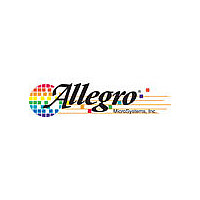A4490EES-T Allegro Microsystems Inc, A4490EES-T Datasheet - Page 10

A4490EES-T
Manufacturer Part Number
A4490EES-T
Description
IC REG STEP DOWN SW TRPL 20-QFN
Manufacturer
Allegro Microsystems Inc
Type
Step-Down (Buck)r
Datasheet
1.A4490EES-T.pdf
(16 pages)
Specifications of A4490EES-T
Package / Case
20-WFQFN
Internal Switch(s)
Yes
Synchronous Rectifier
No
Number Of Outputs
3
Voltage - Output
Adjustable
Current - Output
1.5A
Frequency - Switching
550kHz
Voltage - Input
4.5 ~ 34 V
Operating Temperature
-40°C ~ 85°C
Mounting Type
Surface Mount
Primary Input Voltage
34V
No. Of Outputs
3
Output Voltage
5V
Output Current
1.5A
Voltage Regulator Case Style
QFN
No. Of Pins
20
Operating Temperature Range
-40°C To +85°C
Svhc
No SVHC
Rohs Compliant
Yes
Lead Free Status / RoHS Status
Lead free / RoHS Compliant
For Use With
620-1388 - BOARD EVAL FOR A4490
Power - Output
-
Lead Free Status / RoHS Status
Lead free / RoHS Compliant, Lead free / RoHS Compliant
Other names
A4490SES-T
A4490SES-T
A4490SES-T
A4490
The bias current, I
introduce a small voltage offset to the output.
Enable Each regulator channel can be individually enabled via
the corresponding ENBx pin. If any channel is required to start-
up automatically after the VBB voltage is applied, that particu-
lar channel should have the ENB pin tied to the VBB rail via a
pull up resistor.
This resistor should be selected to limit the current to less than
the maximum specified value, 1 mA. This prevents the internal
protection clamps from turning on. It is recommended that a
100 kΩ pull-up resistor be used. This would ensure the current
remains below the maximum value when V
Soft Start Each regulator channel contains a soft start circuit. A
soft start cycle is initiated when the appropriate regulator enable
input is set to high; the V
ages are above the minimum values; and no thermal shutdown
condition exists. Note that an overload or short circuit will not
cause a soft start cycle, unless a thermal shutdown event occurs.
During a soft start cycle, the reference voltage is ramped from
0 to 0.8 V typical, which in turn forces the current demand signal
to increase in a linear fashion.
Shutdown All converter channels are disabled in the event of
either a thermal shutdown event or an undervoltage on VBB
(V
As soon as the above fault conditions have been removed, and
assuming the ENB inputs are enabled, the appropriate channels
will auto-restart under control of the soft start.
Current Limit The typical peak current limit for each channel is
specified as 2.5 A minimum, with a duty cycle of 0.9. The mini-
mum current limit occurs at maximum duty cycle (0.9), because
the slope compensation has a maximum effect under this condi-
tion. As the duty cycle reduces, the current limit increases. This
means for applications that operate with a narrow duty cycle, it is
possible to operate with a load current greater than 2.0 A.
Figure 3 illustrates the typical peak current limit versus duty
cycle. For example, it is possible to operate with a peak current
limit of 3.75 A with a duty cycle of 0.3.
As well as ensuring the peak current limit is not exceeded, under
worst case load and input voltage conditions, it is also important
BBUV(sd)
or V
BBCPUV(sd)
BIAS
, flowing out of the FB1 node into R2, will
BB
).
, charge pump, and bias supply volt-
Triple Output Step-Down Switching Regulator
BB
= 36 V.
to check the implications on the thermal performance. See the
Thermal Considerations section.
Component Selection
Inductor The inductance value, L, determines the ripple current.
It is important to ensure that the minimum current limit is not
exceeded under worst-case conditions: V
f
It is recommended that gapped ferrite solutions be used as
opposed to powdered iron solutions, the latter of which exhibit
relatively high core losses that can have a large impact on long
term reliability.
Inductors are typically specified at two current levels, rms cur-
rent and saturation current. With regard to the rms current, it is
important to understand how the rms current level is specified,
in terms of ambient temperature. Some manufacturers quote an
ambient only, whilst others quote a temperature that includes a
self-induced temperature rise. For example, if an inductor is rated
for 85°C and includes a self-induced temperature rise of 25°C
at maximum load, then the inductor cannot be safely operated
beyond an ambient temperature of 60°C at full load. The rms cur-
rent can be assumed to be simply the maximum load current, with
perhaps some margin to allow for overloads, and so forth.
The first stage of determining the inductor value is to specify a
peak-to-peak ripple current of typically about 20% to 25% of the
maximum load.
Figure 3. Current limit versus duty cycle
SW
(min), and L(min).
5.0
4.5
4.0
3.5
3.0
2.5
2.0
1.5
0.5
1.0
0.5
0
0
20
115 Northeast Cutoff
1.508.853.5000; www.allegromicro.com
Allegro MicroSystems, Inc.
Worcester, Massachusetts 01615-0036 U.S.A.
40
Duty Cycle (%)
60
BB
(min), I
80
LOAD
(max),
100
10















